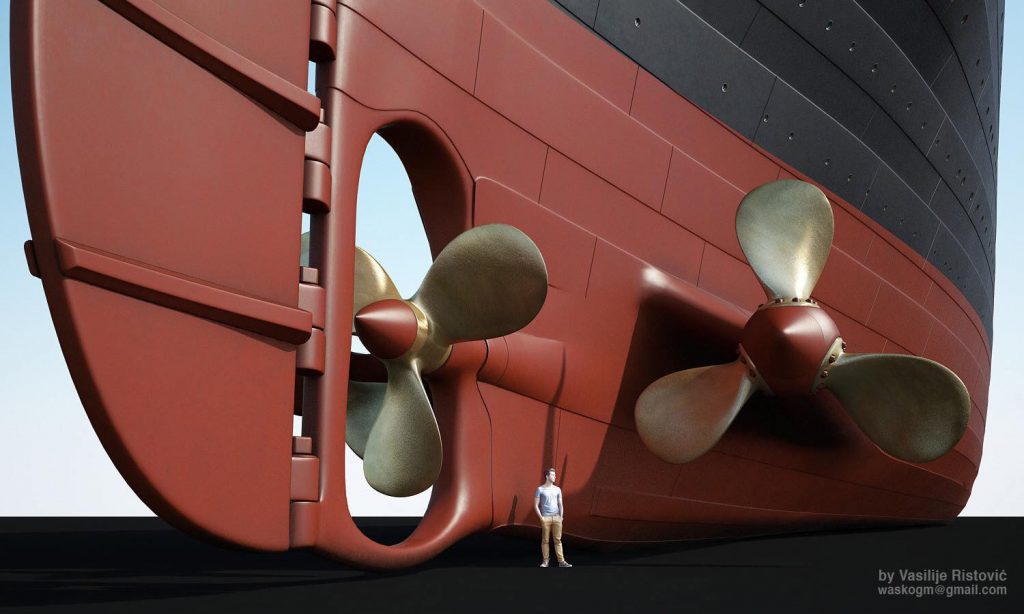For decades, it was simply assumed that Titanic‘s propeller configuration was the same as her sister Olympic‘s. This assumption became accepted as fact. All too often, photos of Olympic‘s propellers were used to stand in for Titanic without the descriptions making clear that they were photos of her older sister ship. (There are no known photos of Titanic in dry dock with her propellers fitted and visible.)
However, in 2007 I was researching the Harland & Wolff records (supported by a local researcher, Jennifer Irwin). This material had been deposited with Public Record Office Northern Ireland (PRONI) between 1972 and 1994. It included documentation colloquially referred to as the ‘Harland & Wolff order book’, which kept a record of the key dates for each ship such as the contract date, when the shipyard and engine works were ordered to proceed, when the keel was laid, when the double bottom was completed, when the hull was fully framed, when the ship was launched and delivered. The ship’s basic dimensions and propelling machinery details were also recorded.
Of particular interest to ‘rivet counters’ or technical researchers was a series of five volumes of engineering notebooks, which focused on the technical aspects of the hundreds of ships they completed, as built: these included each ship’s size, displacement and propelling machinery particulars in great detail (such as the size of engine components, the boiler specifications and propeller specifications). The details were recorded meticulously. It is not clear exactly when they were transferred from Harland & Wolff, but the best guess is that this was probably the early 1970s. These records were also classified as closed, subject to researchers making a specific application to review them, which stands in contrast to other archival records that are classified as open (without such access restrictions).
The entries for Titanic state that her propeller configuration had an increased pitch of the port and starboard propeller blades (compared with the 1911 Olympic configurations) and a slightly larger centre propeller which had three blades instead of four. In other words, contrary to the assumption that Titanic‘s propeller configuration was closest to Olympic as she was in 1911, it was closer visually to Olympic‘s configuration after her 1912-13 refit. In hindsight, there should be nothing surprising about this. Shipbuilders of the period were constantly tweaking and experimenting with the optimum propeller designs and we know from J. Bruce Ismay’s testimony that Harland & Wolff had advised him they expected Titanic to be slightly faster than Olympic.
This material from Harland & Wolff is a primary source, which is far superior to secondary source material. As explained in the Harvard Library’s Research Guide for the History of Science:
Primary sources provide first-hand testimony or direct evidence concerning a topic under investigation. They are created by witnesses or recorders who experienced the events or conditions being documented.
Secondary sources were created by someone who did not experience first-hand or participate in the events or conditions you’re researching.
The key distinction here is that, whereas many secondary sources simply repeated an assumption about Titanic‘s propellers that was made by people who were not there in 1912, the primary source material was produced first hand by personnel at Harland & Wolff who were tasked with keeping a record of each completed ship’s technical particulars. It is the contemporary record which was kept by the shipbuilding firm who completed Titanic in 1912.
This dossier groups together the primary source evidence and analysis of that material, including the Harland & Wolff evidence published in 2008 and other supporting evidence discovered by other researchers in the years since.
Sadly, Titanic’s propeller configuration has been the subject of ill-tempered and vitriolic arguments online. What was simply an interesting discovery of a previously unknown difference between her and her older sister ship has become the topic of frequent hysteria. Nonetheless, despite all these arguments, there is no debate as far as the primary source evidence is concerned. From the historian’s perspective, what counts is that our interpretation is based on the best available evidence. The best information we have about Titanic’s propeller configuration (to date) is Harland & Wolff’s own records.

Above: A stunning illustration of how Titanic‘s propellers most likely appeared, based on the propeller specifications recorded by Harland & Wolff. (Courtesy Vasilije Ristovic, 2019)




